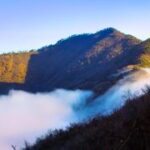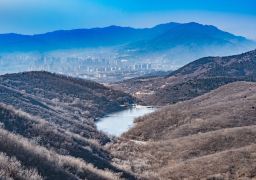Mingzhao Temple, also known as Hui’an Temple or Zhijue Temple, is located on Mingzhao Mountain, 3 kilometers east of Wuyi County. It was first established in the early years of the Eastern Jin Dynasty by Ruan Fu, the great-grandson of Ruan Ji, one of the ‘Seven Sages of the Bamboo Grove.’
Since Ruan Fu donated his residence to build the temple, over 1600 years have passed, predating Hangzhou’s Lingyin Temple by more than 500 years. The temple has undergone many changes and renovations, with only the mountain gate being relatively well-preserved to this day. After Ruan Fu’s death, he was buried on Mingzhao Mountain. In his memory, one of the mountains was named Lajie Mountain, with structures such as the Lajie Pavilion, Jin Diao Pavilion, and Huanjiu Pavilion built on it; these remains still exist today. During the Song Dynasty, Neo-Confucianist Lu Zuqian moved the graves of his ancestors to Mingzhao Mountain and set up a lecture hall at Mingzhao Temple, where he lectured alongside renowned scholars like Zhu Xi, Chen Liang, Ye Shi, and Gong Feng. Scholars from all over the country gathered here to discuss academics, write books, and establish theories, making it one of the most prestigious institutions in the country. The Zhu-Lu Lecture Hall and the Lu Family Ancient Tombs are still preserved to this day. Mingzhao Temple is surrounded by mountains with clear and elegant peaks. In front of the temple, there is a pond and a small hill shaped like a steamed bun, which geologically should be a volcanic crater. This hill is locally known as ‘Bomo Peak,’ surrounded by nine peaks converging from different directions, resembling nine dragons, hence it is also called ‘Wan Zhu Mountain,’ symbolizing the ‘dragons competing for a pearl.’ Essential Tips: Ruan Fu, a native of the Jin Dynasty’s Yuzhi, served as a constant attendant to the emperor during the reign of Emperor Yuan. He was known for his daily indulgence in wine and once exchanged the emperor’s gift of a golden mink for wine, yet the emperor always forgave him. In the early years of the Eastern Jin Dynasty (326-327 AD), when the Empress Dowager listened to court affairs, Ruan Fu foresaw an impending chaos and requested an external appointment as the General of the Southern Town. On his way to Guangzhou, he heard about the rebellion of Su Jun, and thus he settled in Wuyi’s Mingzhao Mountain, building a house and living in seclusion. He often enjoyed wine and wore wooden clogs for leisurely walks in the mountains and waters, content with his life. He once said, ‘I wonder how many pairs of clogs I will wear in my life?’ He was very detached. After his death, he was buried on Mingzhao Mountain. In his memory, one of the mountains was named Lajie Mountain, with structures such as the Lajie Pavilion, Jin Diao Pavilion, and Huanjiu Pavilion built on it; these remains still exist today.Mingzhao Temple
Mingzhao Temple, also known as Hui’an Temple or Zhijue Temple, is located on Mingzhao Mountain[...]









